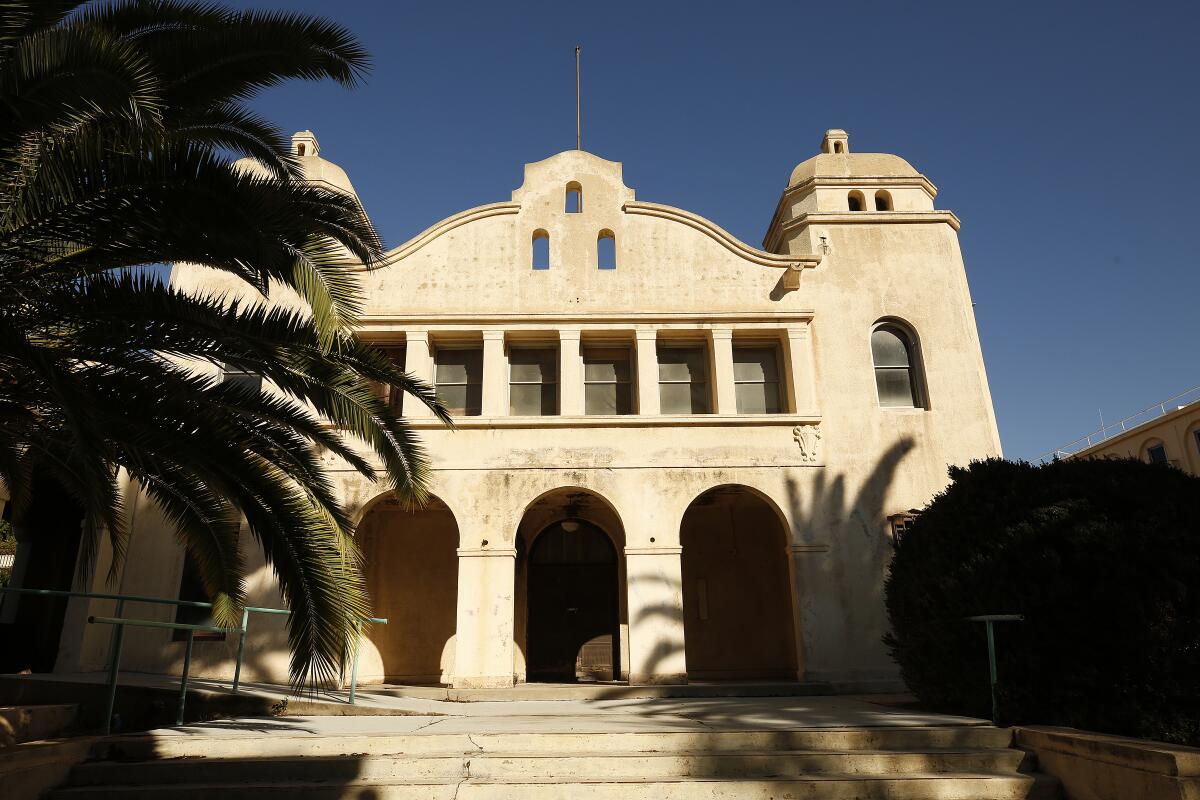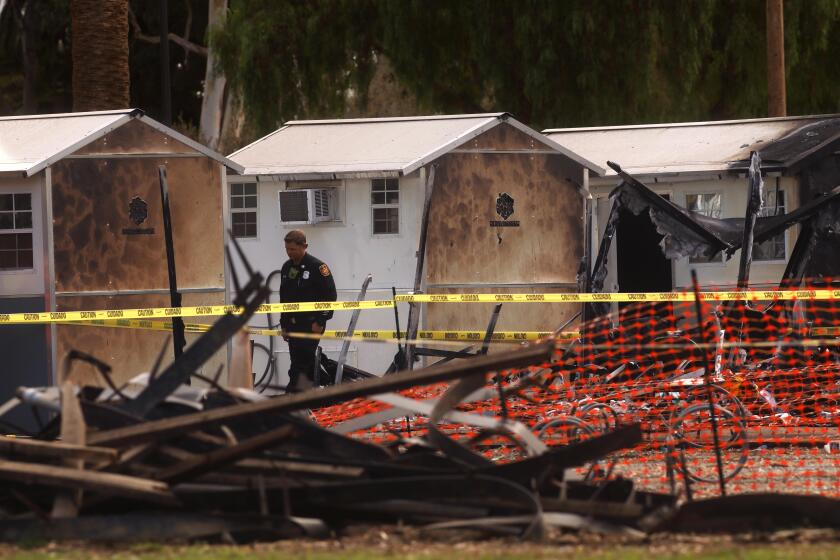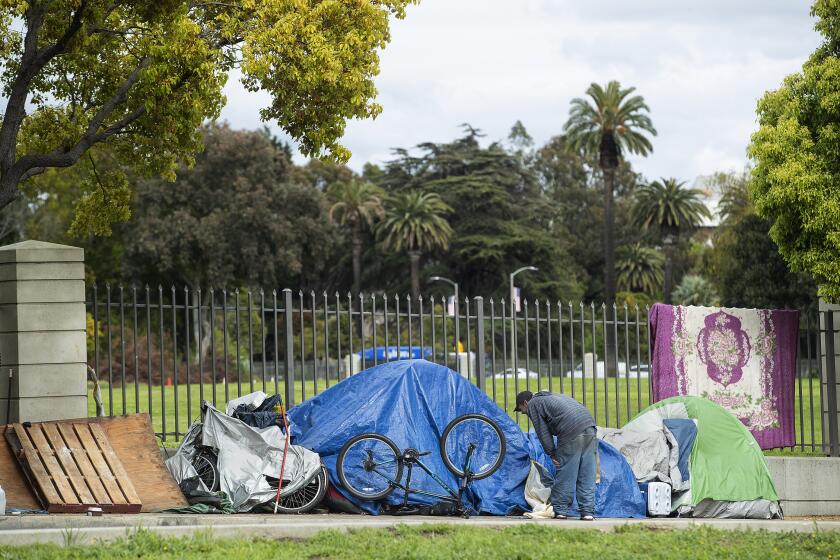Editorial: Finally, more housing for homeless veterans opens on the VA campus. Still problems? Of course

- Share via
Only three months ago, the U.S. Department of Veterans Affairs had just 54 units of permanent housing for homeless people on its sprawling West Los Angeles campus, a dismal installment on the agreement it made to create 1,200 units as part of a sweeping master plan drawn up in 2016. That plan was the result of a lawsuit and settlement with homeless veterans who argued that the VA wasn’t fulfilling its primary obligation to be a home for veterans, not just a medical center with the land for lease to outside interests.
Then last month, 59 units in a rehabbed historic building were completed and veterans began to move into the small but beautiful apartments, many with large arched windows offering airy views of the VA campus. In the next several weeks, 120 more units will become available in two buildings, bringing the total to 233 apartments. Construction continues and by the end of 2024, more than 600 units should be open — or close to being open — according to Tyler Monroe, senior vice president of development for Thomas Safran & Associates, one of the three firms that constitute the principal developer team for the housing and amenities that will make up a veterans community on the north portion of the campus.
That’s slower than having 480 new homes in place by 2020 as the master plan had called for. But it’s encouraging to finally see more homeless veterans moving into stable housing on land dedicated to their care and well-being.
At this rate, VA timetables estimate that all 1,200 units could be done by mid-2030. That’s still four years off the master plan’s original forecast. And we hope the project can reach its goal of 1,200 units sooner — the need is so great. By the 2022 homeless count, there were about 3,900 homeless veterans in Los Angeles County. One thing the VA can do to make sure it hits at least the 2030 date is to release control of the land parcels to developers by 2028.
A new lawsuit says the VA has miserably failed homeless veterans on its West Los Angeles campus.
The project has had big obstacles: an environmental study that took two years, an aged infrastructure (decrepit sewer lines and water supply systems among other problems) that wasn’t ready for substantial residential development, and the arduous task of assembling affordable housing financing from various sources.
Indeed, the latest glitch is related to some of that financing. When residents were being selected for the newly opened Building 207, which is restricted to homeless senior veterans, some homeless veterans, by virtue of their VA disability payments, were making too much money to qualify. Financing for the building, including money from the city’s Proposition HHH funds, requires that tenants’ income is no more than 30% of the area median income.
But veterans who are considered completely disabled — and would benefit most from living close to the VA hospital and services on campus — are getting monthly disability payments that put them at 50% of area median income. Finding a veteran of the right age group and poverty level was like looking for “a unicorn,” one VA official told an advisory group last month.
Since then, the director of the L.A. Housing Department, noting the difficulty the VA has had in finding tenants who match the income requirements, asked the City Council to allow the limit on HHH unit eligibility to be raised to 50% of area median income in VA supportive housing as needed. The council agreed to do so. While the VA should always be trying to find and house the most destitute of its veterans, it’s absurd to have units on the campus sit empty while the VA searches for homeless veterans poor enough to qualify.
The VA managed to house permanently 221 homeless veterans in under two months. That’s good, but it can do better.
Assembly Bill 1386, which has been introduced in the Legislature, would allow veterans with up to 60% of area median income to be placed in homeless housing built with financing from the state Veterans Housing and Homelessness Prevention Program, while still instructing housing developments to prioritize veterans making less than that.
The VA also has funding from the PACT Act, which President Biden signed into law last year to expand VA healthcare and benefits for veterans exposed to toxic substances. The legislation includes funds that the VA may use for development of supportive housing projects, with more than $350 million available for the West L.A. campus. It would be great if the VA would funnel some of that PACT money to the housing developers so they don’t have to raise as much money and can move projects along faster. (The VA only supplies the land and pays for infrastructure.)
The fact that this development project finally has momentum is good news, long awaited by veterans and their advocates who have watched for years in frustration as VA officials failed to transform the campus from little more than a medical center into the residential community and gathering place they were promised. Now that building has begun, let’s see the VA and the developers try to speed it up even more. Every day on a sidewalk, in a tent, under an overpass, is another day that unhoused men and women who served their country are left without homes to call their own.
More to Read
A cure for the common opinion
Get thought-provoking perspectives with our weekly newsletter.
You may occasionally receive promotional content from the Los Angeles Times.











